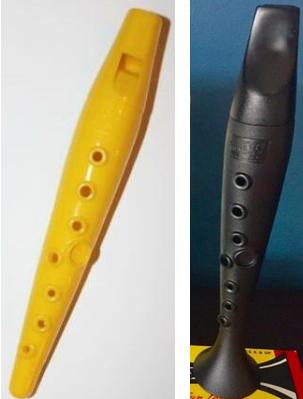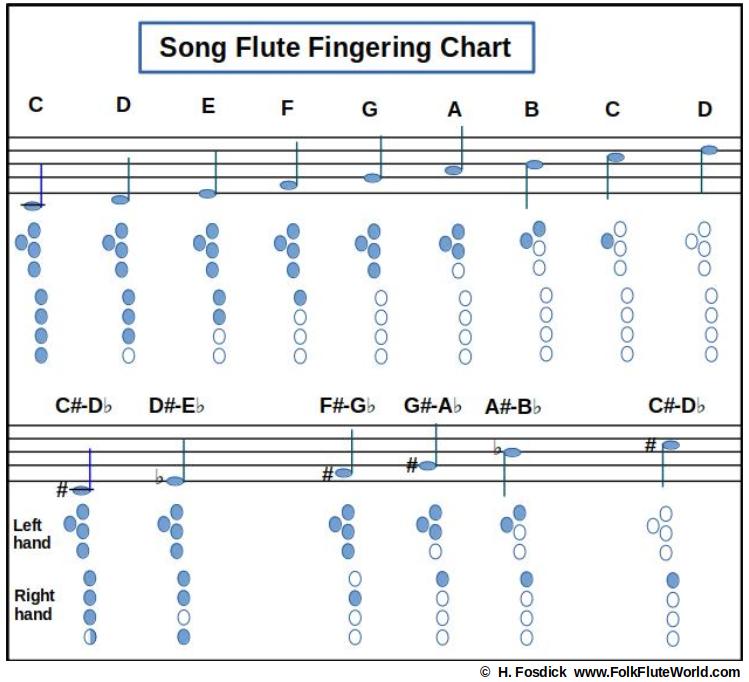by Howard Fosdick © FolkFluteWorld.com.
Song flutes are the perfect introduction to musical instruments. It's easy to see why.
They're simple: they lack mechanical keys and the holes are easy to are all easy to reach. Schools often introduce this inexpensive, easy-to-play instrument for children to learn basic music skills. They often transition to more complicated instruments later, like the clarinet, flute, or saxophone.
As an adult, why would you care? Because these cheap little flutes -- even though limited in important ways -- can still play beautiful music! They're cheap, portable and fun. And as we'll demonstrate through several sound samples, the song flute's dulcet voice can be pleasant indeed.
If you're new to playing an instrument, there's no easier place to start than with this simple flute. If kids can play it, you can, too.
If you already play a woodwind, you'll be able to play this archetypal flute as soon as you pick it up. You'll have found a fun new voice for your repertoire... no learning curve required.
Free sheet music included, it's all available for the cost of a meal. This article tells you everything you need to know about the versatile little song flute.
What's a Song Flute?
Song flutes were invented in the late 1930s by Elver Fitchhorn. They're sometimes called the "Fitchhorn Flute." Song flutes carry the stamped identifier "Song Flute" and/or the makers mark of Fitchhorn, Selmer, Conn-Selmer, or Conn.
The instruments were widely popular for early music education from the 1930s through the 1970s. Their popularity tailed off with the introduction of high-quality plastic recorders in the '70s and '80s. Recorders are more difficult to play but are way more musically capable. Today, some grade schools still employ song flutes... as do a tiny coterie of musical cognescenti.
The song flute consists of a single piece of molded plastic. This means it's very inexpensive, but there's also a downside. First off, you can't tune it. And for cleaning it is less convenient than flutes that offer removable mouthpieces. You wash it by full immersion in soapy warm water.
Like the Model T Ford, song flutes come in every color you might want... so long as that color is black:


(Photos courtesy of Amazon and The OnMusic Dictionary @Dictionary.Onmusic.org)
People often confuse the song flute with the tonette, a competing plastic flute that comes in many colors but is also most often seen in black. Though they share many similarities -- such as key and fingering -- song flutes and tonettes are different instruments. Each has its unique voice. (For more on the tonette, read my companion article The Ultimate Guide to the Tonette).
You can see that the tonette lacks the song flute's gently curved tail, as well as its distinctive raised paths between the finger holes:

(Photos courtesy of vendor "iclaura" at eBay and Gibson)
Sound
I've claimed the primitive song flute can sound beautiful, so before going any further, let's listen to a few sound clips. Each was recorded using a different instrument and microphone:
- This improvisation describes a kitten viciously stalking his playtoy
- Here's a stairwell improv from Youtube
- A Christmas song
The song flute's slightly airy voice projects best within a resonant environment, such as a hallway, stairwell, or basement. A bit of natural reverb enhances its acoustics. I enjoy playing my song flute in the stairwell that leads to my unfinished basement.
How to Play
Playing this little flute is simplicity itself. There is no reed to bother about, as with saxes or clarinets or oboes. Nor do you have to spend a week learning how to blow into it properly, as beginners must with concert flutes.
Simply put your mouth on the fipple and blow. To play an ascending scale, cover all holes with your fingers and progressively lift each finger. You'll notice the raised holes are easier to cover than a recorder's.
The flute's range is only a scale plus a note, from C5 through D6. That's its main limitation. Concert woodwinds play from two-and-one-half to three full octaves. Even folk flutes like tin whistles (penny whistles) and recorders can play over two octaves.
You can play all sharps and flats within the instrument's range by cross-fingering (sometimes referred to as forked or split fingering).
There is one exception: playing low C# requires half-holing the bottom-most hole. That's no problem for experienced players but it challenges beginners.
Here's a fingering chart:

(Chart by H. Fosdick)
Alternate fingerings exist for several notes. Particularly with the sharps and flats you should experiment with your instrument to find what sounds best for your breath pressure.
Learning to Play
The song flute's C5 base note is one octave above middle C on the piano. That's the same base note of many other folk flutes, including tonette, soprano recorder, C tin whistle, flutophone, precorder, and the common alto ocarina.
This means you can play the tons of free sheet music downloadable for all those instruments. You'll never have to buy a score.
And here is a list of other free resources that are useful.
The song flute's limited range of 9 whole notes occasionally presents an issue with music written for recorder and tin whistle because those instruments have broader range. You may have to transpose some songs to a suitable key. Others you may be forced to skip altogether.
Practically speaking, you can play nearly any tune on a song flute so long as it's in an appropriate key.
The song flute is so simple you won't need an instructional book unless you're entirely new to playing an instrument. If you do want one you'll find several at Amazon. Search the "books" category using keywords "tonette" or "flutophone."
Tutorials for these instruments are largely interchangeable. (If you search on "song flute" you'll get irrelevant results.)
I don't recommend methods that teach recorder, D tin whistle, or concert flute. Those instruments are too different to be applicable to learning song flute.
Finding an Instrument
Song flutes don't all sound the same. Older ones have a shiny, glossy appearance. Those from the last several decades are non-reflective. They're typically flat black or matte finish.
In my experience, the highly reflective, older material produces better sound. Perhaps it's denser or reflects sound waves differently? Whatever the case, to obtain a great sounding instrument, stay away from the newer flutes. Seek out an older, used item from eBay or other reseller.
I recommend buying a flute made before 1970. Test it yourself if at all possible. That's your best assurance you'll get an instrument that produces quality sound.
Ironically, the market doesn't recognize the tonal differences among song flutes. You'll pay the same $10 to $20 for a sweet-sounding instrument as you would for an off-key kid's toy.
Why Not?
Folk flutes unleash your creativity with minimal investment. For just a few dollars you can enjoy playing around with a new sound on your portable flute. Sheet music is free. And it takes just a few hours to develop the skills to experience real joy in playing.
The song flute is a paradox. I have an entire collection of folk flutes, yet every now and then I return to the song flute, with its simplicity and pure voice.Its soothing voice can touch your soul.